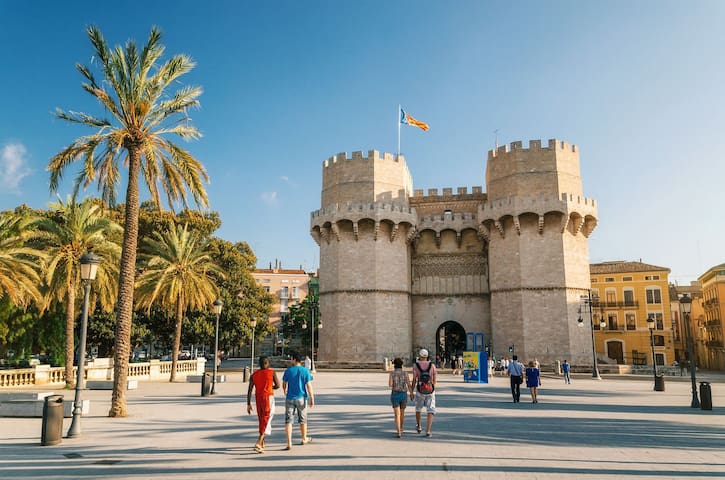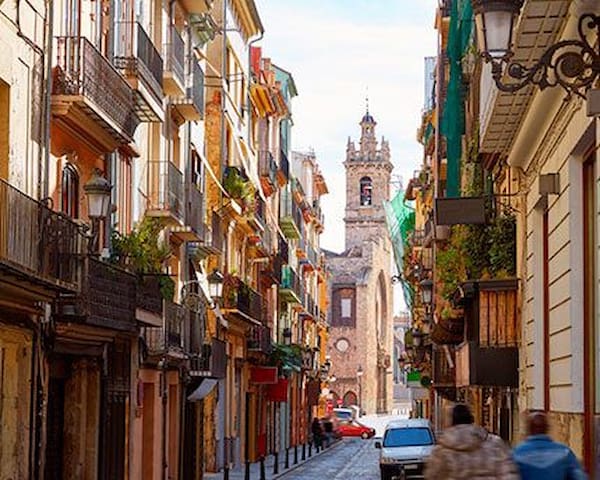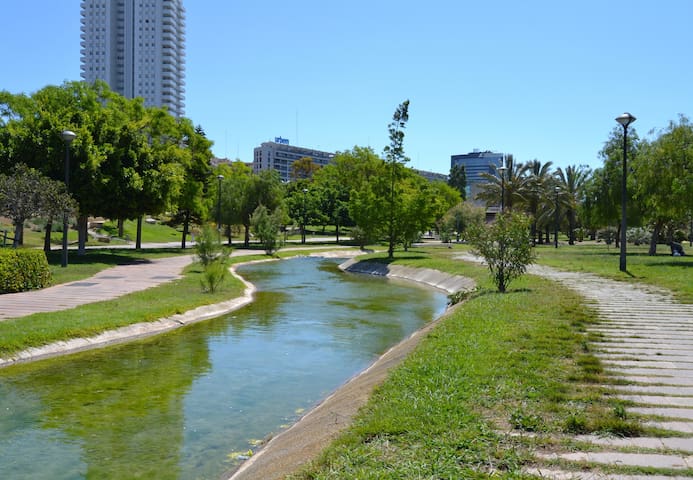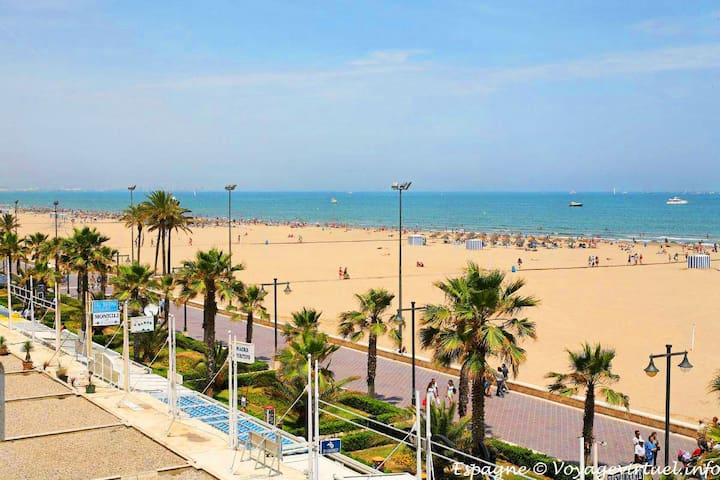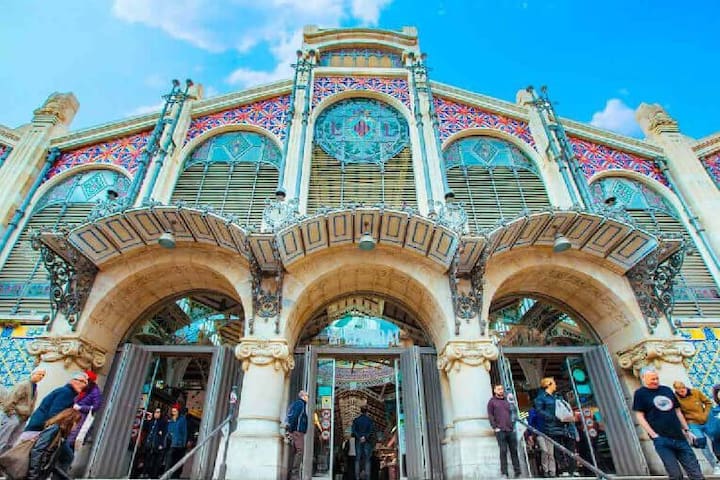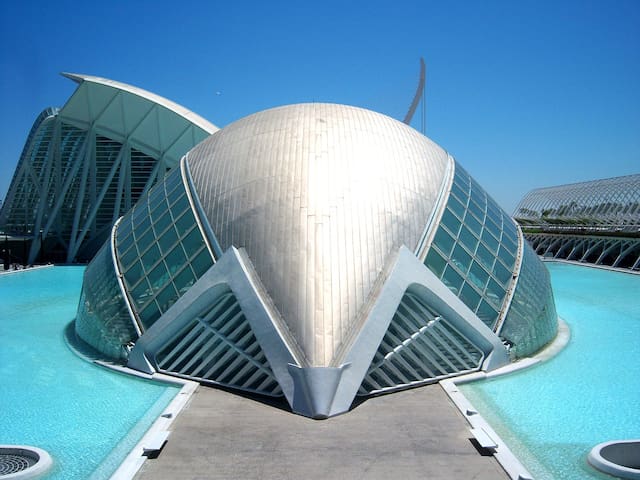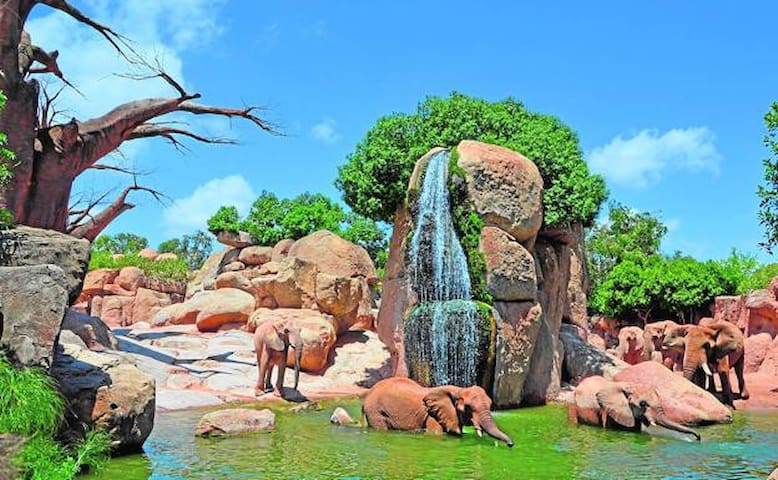Barrios
Visit the Old Town, which is 2000 years old and the result of a mix of city cultures and backgrounds: from Roman to Muslim and Christian. One of my favorite attractions is the Mercado Central (Central Market), open Mon.-Sat. from 07:30-14:30 (closed on Sundays). Have some tapas at Central Bar by renowned local chef Ricard Camarena, a small bar inside the market. My preferred tapas: “ensaladilla rusa”, “croquetas de pollo”, “buñuelos de bacalao” and “patatas bravas”. It might be crowded (especially on Saturdays), so be prepared for a wait.
Pop across the road to La Lonja de la Seda, open Mon.-Sat. from 09:30-19:00, entrance: 2 EUR; Sundays and bank holidays from 09:30-15:00, free admission. This was the Silk Exchange, built between 1482 and 1533, and nowadays is a UNESCO World Heritage site. It is made of three rooms almost empty and a beautiful small garden.
Continue versus the Plaza del Tossal and take the charismatic Calle Caballeros to the Plaza de la Virgen. You will see the Palau de la Generalitat, the Basilica, the Cathedral, the Miguelete (main bell tower). Visit the Church of San Nicolas (the so called Valencian Sistine Chapel). You can also seek out Torres de Serranos (Serrano Towers), north of the Carmen, near the old riverbed, and there is a great view and a photo shot across the river. Stop and enjoy a coffee or a drink at the Plaza del Doctor Collado or the Plaza del Negrito, or in one of the terraces in the surroundings of the Central Market and the Lonja.
Walk to the Plaza del Ayuntamiento (City Hall Square) and enter the magnificent Post Office. Visit also the City Hall and its Balcony, the Crystal Room and the Historical Museum (free admission and open Mon.-Fri., from 9:00-14:00).
South of Plaza del Ayuntamiento, you can see the wonderful modernist train station “l’Estació del Nord” (Nord Railway Station),the Plaza de Toros (Bull Ring) and then head along Calle Colón for a little light shopping in Camper, Zara, Massimo Dutti, El Corte Inglés and other Spanish shops. In Calle Jorge Juan you will find some other nice Spanish brands and boutiques. Once there, you could stop at the Mercado de Colón for a refreshing “horchata”
507 місцеві жителі рекомендують
El Carmen
Visit the Old Town, which is 2000 years old and the result of a mix of city cultures and backgrounds: from Roman to Muslim and Christian. One of my favorite attractions is the Mercado Central (Central Market), open Mon.-Sat. from 07:30-14:30 (closed on Sundays). Have some tapas at Central Bar by renowned local chef Ricard Camarena, a small bar inside the market. My preferred tapas: “ensaladilla rusa”, “croquetas de pollo”, “buñuelos de bacalao” and “patatas bravas”. It might be crowded (especially on Saturdays), so be prepared for a wait.
Pop across the road to La Lonja de la Seda, open Mon.-Sat. from 09:30-19:00, entrance: 2 EUR; Sundays and bank holidays from 09:30-15:00, free admission. This was the Silk Exchange, built between 1482 and 1533, and nowadays is a UNESCO World Heritage site. It is made of three rooms almost empty and a beautiful small garden.
Continue versus the Plaza del Tossal and take the charismatic Calle Caballeros to the Plaza de la Virgen. You will see the Palau de la Generalitat, the Basilica, the Cathedral, the Miguelete (main bell tower). Visit the Church of San Nicolas (the so called Valencian Sistine Chapel). You can also seek out Torres de Serranos (Serrano Towers), north of the Carmen, near the old riverbed, and there is a great view and a photo shot across the river. Stop and enjoy a coffee or a drink at the Plaza del Doctor Collado or the Plaza del Negrito, or in one of the terraces in the surroundings of the Central Market and the Lonja.
Walk to the Plaza del Ayuntamiento (City Hall Square) and enter the magnificent Post Office. Visit also the City Hall and its Balcony, the Crystal Room and the Historical Museum (free admission and open Mon.-Fri., from 9:00-14:00).
South of Plaza del Ayuntamiento, you can see the wonderful modernist train station “l’Estació del Nord” (Nord Railway Station),the Plaza de Toros (Bull Ring) and then head along Calle Colón for a little light shopping in Camper, Zara, Massimo Dutti, El Corte Inglés and other Spanish shops. In Calle Jorge Juan you will find some other nice Spanish brands and boutiques. Once there, you could stop at the Mercado de Colón for a refreshing “horchata”
Enjoy El cabanyal, considered historical heritage of the city, and one of the alternative areas of Valencia where much of the cultural life of Valencia develops.
You can’t truly discover the essence of Válencia without strolling through the city’s seaside neighbourhoods, where the customs of the former fishermen are still present between small buildings of popular modernism. Visit the Mercado del Cabanyal, open Mon.-Sat. from 07:00-14:30, and Fridays until 20:30 (closed on Sundays). Go there in the morning to enjoy its full activity and just walk around; visit the impressive fish and sea food section; buy some fresh fruits, vegetables, ham, cheese, mojama de atún (wind-dried tuna), olives, pickled “encurtidos”, or some Valencian wine… And just look up and around you. Have a Valencian almuerzo or some tapas at Bar Cabanyal, located in Martí Grajales 5 Street, next to the market. Don’t miss the “Mercadillo” (street market) every Thursday morning, taking place in our street and the streets surrounding the Mercado del Cabanyal area. Enjoy some of the nice tapas bars and restaurants of the neighbourhood: Bodega Casa Montaña (it’s not cheap, but the place is worth a visit, at least for a glass of wine… or/and some Spanish ham), Bodega Anyora, L’Áncora or Ca La Mar are good examples.
137 місцеві жителі рекомендують
El Cabanyal
128 Carrer de la ReinaEnjoy El cabanyal, considered historical heritage of the city, and one of the alternative areas of Valencia where much of the cultural life of Valencia develops.
You can’t truly discover the essence of Válencia without strolling through the city’s seaside neighbourhoods, where the customs of the former fishermen are still present between small buildings of popular modernism. Visit the Mercado del Cabanyal, open Mon.-Sat. from 07:00-14:30, and Fridays until 20:30 (closed on Sundays). Go there in the morning to enjoy its full activity and just walk around; visit the impressive fish and sea food section; buy some fresh fruits, vegetables, ham, cheese, mojama de atún (wind-dried tuna), olives, pickled “encurtidos”, or some Valencian wine… And just look up and around you. Have a Valencian almuerzo or some tapas at Bar Cabanyal, located in Martí Grajales 5 Street, next to the market. Don’t miss the “Mercadillo” (street market) every Thursday morning, taking place in our street and the streets surrounding the Mercado del Cabanyal area. Enjoy some of the nice tapas bars and restaurants of the neighbourhood: Bodega Casa Montaña (it’s not cheap, but the place is worth a visit, at least for a glass of wine… or/and some Spanish ham), Bodega Anyora, L’Áncora or Ca La Mar are good examples.
Visit Ruzafa (also spelt Russafa), currently the most fashionable district in Valencia. You will find art galleries, cool shops (such as Gnomo) and bookstores (Bartleby, Ubik Café), lots of lively restaurants and bars with terraces and also clubs offering a more alternative atmosphere. Ruzafa is where most Valencians go out for dinner and hang out.
In the morning I recommend to stop for breakfast or brunch at “Dulce de Leche”, an Argentinean pastry shop (try the strawberry and lemon tart!) or at the beautifully decorated “La Más Bonita” (don’t miss their home-made and delicious cakes; my favourite, the “red velvet” one…); drop by the multi-coloured retro-chic Mercat de Russafa (Ruzafa’s municipal market, open Monday to Saturday), a foodie’s paradise offering the same luscious produce as the celebrated Central Market, but without the hordes of tourists; for a beer and tapas at midday, La Cooperativa del Mar
(ancient fish shop where you can eat fish cans – sardines, anchovies, tuna, spicy eel…). If you haven’t tried the Agua de Valencia (cava with orange juice), ask for one at the terrace of Café 33. For lunch or dinner, one of my favourite places is Canalla Bistro, from the famous Valencian Chef Ricard Camarena. Bar Vermúdez and La Tasqueta Del Mercat are also great places to eat out. If you like Japanese food, Hikari Yakitori Bar and Tora taberna japonesa, are some of the best Japanese informal options in Valencia.
443 місцеві жителі рекомендують
Russafa
Visit Ruzafa (also spelt Russafa), currently the most fashionable district in Valencia. You will find art galleries, cool shops (such as Gnomo) and bookstores (Bartleby, Ubik Café), lots of lively restaurants and bars with terraces and also clubs offering a more alternative atmosphere. Ruzafa is where most Valencians go out for dinner and hang out.
In the morning I recommend to stop for breakfast or brunch at “Dulce de Leche”, an Argentinean pastry shop (try the strawberry and lemon tart!) or at the beautifully decorated “La Más Bonita” (don’t miss their home-made and delicious cakes; my favourite, the “red velvet” one…); drop by the multi-coloured retro-chic Mercat de Russafa (Ruzafa’s municipal market, open Monday to Saturday), a foodie’s paradise offering the same luscious produce as the celebrated Central Market, but without the hordes of tourists; for a beer and tapas at midday, La Cooperativa del Mar
(ancient fish shop where you can eat fish cans – sardines, anchovies, tuna, spicy eel…). If you haven’t tried the Agua de Valencia (cava with orange juice), ask for one at the terrace of Café 33. For lunch or dinner, one of my favourite places is Canalla Bistro, from the famous Valencian Chef Ricard Camarena. Bar Vermúdez and La Tasqueta Del Mercat are also great places to eat out. If you like Japanese food, Hikari Yakitori Bar and Tora taberna japonesa, are some of the best Japanese informal options in Valencia.
Lugares emblemáticos
Turia Gardens in Valencia (the old course of the Turia river transformed into gardens) It is the largest urban garden in Spain, it’s about 9 km long and 110 hectares. After a flood in 1957, the river Turia was diverted to the south of the city and Valencians turned it into a park. Its route is dotted by many places of interest: the Palau de la Música, the stunning City of Arts and Sciences, designed by Valencia architect Santiago Calatrava. If you are coming with children, the Gulliver Park, the Bioparc (best and largest zoological park in Europe) and the Cabecera Park... The Turia Gardens has many sports facilities in its route (including a 5 km running track). The best way to enjoy it is by bike. You can rent one at a private rental shop, or maybe buy a weekly subscription in order to use the municipal bicycle sharing system ValenBisi, which is limited to 30-minutes use every time that you rent one in the dedicated stations located all around the city.
Rio TURIA Ribarroja. Area recreativa L'Explanada
Turia Gardens in Valencia (the old course of the Turia river transformed into gardens) It is the largest urban garden in Spain, it’s about 9 km long and 110 hectares. After a flood in 1957, the river Turia was diverted to the south of the city and Valencians turned it into a park. Its route is dotted by many places of interest: the Palau de la Música, the stunning City of Arts and Sciences, designed by Valencia architect Santiago Calatrava. If you are coming with children, the Gulliver Park, the Bioparc (best and largest zoological park in Europe) and the Cabecera Park... The Turia Gardens has many sports facilities in its route (including a 5 km running track). The best way to enjoy it is by bike. You can rent one at a private rental shop, or maybe buy a weekly subscription in order to use the municipal bicycle sharing system ValenBisi, which is limited to 30-minutes use every time that you rent one in the dedicated stations located all around the city.
City Beach area & La Marina de Valencia: Have breakfast or brunch at “La Más Bonita” on the Playa de la Patacona, and then enjoy a day on the beach. They also have a lovely Chiringuito on the beachfront, right in front of the restaurant, open from 11:00 a.m. to 11:00 p.m. from May to October. If lunch time approaches, you can have a paella at La Pepica (in Las Arenas Beach. La Pepica, inaugurated in 1898, has witnessed all that has happened in the city of Turia throughout the past century. The kings, Hemingway and countless public figures have passed through its tables to try out their mythical paellas. Its decoration is basically marine and offers a typically Valencian cuisine), Casa Carmela (La Malvarrosa beach) or Casa Navarro (in La Patacona). If you want to have a lunch or just a coffee with amazing sea views, try the Panorama restaurant, or one of the bars of the stunning modernist Veles e Vents building, in the Royal Marina. For an after lunch drink (they also have a well-priced restaurant for lunch and dinner), visit the Marina Beach Club (it is right now “the place to be in Valencia”, and gets extremely busy on Friday, Saturday and Sunday afternoons, between 17:00 and until 24:00). As you will be in the area, you can also visit the former America’s Cup Port (also part of the Marina Real). There are a wide variety of water sports on offer at the marina, together with the cultural and gastronomic events held at the iconic Veles & Vents building.
372 місцеві жителі рекомендують
Пляж Мальвароса (Валенсія)
City Beach area & La Marina de Valencia: Have breakfast or brunch at “La Más Bonita” on the Playa de la Patacona, and then enjoy a day on the beach. They also have a lovely Chiringuito on the beachfront, right in front of the restaurant, open from 11:00 a.m. to 11:00 p.m. from May to October. If lunch time approaches, you can have a paella at La Pepica (in Las Arenas Beach. La Pepica, inaugurated in 1898, has witnessed all that has happened in the city of Turia throughout the past century. The kings, Hemingway and countless public figures have passed through its tables to try out their mythical paellas. Its decoration is basically marine and offers a typically Valencian cuisine), Casa Carmela (La Malvarrosa beach) or Casa Navarro (in La Patacona). If you want to have a lunch or just a coffee with amazing sea views, try the Panorama restaurant, or one of the bars of the stunning modernist Veles e Vents building, in the Royal Marina. For an after lunch drink (they also have a well-priced restaurant for lunch and dinner), visit the Marina Beach Club (it is right now “the place to be in Valencia”, and gets extremely busy on Friday, Saturday and Sunday afternoons, between 17:00 and until 24:00). As you will be in the area, you can also visit the former America’s Cup Port (also part of the Marina Real). There are a wide variety of water sports on offer at the marina, together with the cultural and gastronomic events held at the iconic Veles & Vents building.
Fresh food markets
FRESH FOOD MARKETS
Valencia's markets are fully functioning places of trade, where you can watch the hustle and bustle of daily life, the colours of the fruit and vegetables, hear the cries of the stall holders peddling their wares... Whether you would like to pick up some souvenirs to bring back for your loved ones, buy the makings of a picnic or simply soak up the Valencia atmosphere, the following markets are an integral part of the holiday experience:
MERCADO CENTRAL
Valencia’s Central Market is one of the biggest and oldest running fresh-produce markets in Europe and one of the city’s finest examples of Modernist architecture. You should walk around during the morning and feel its nice atmosphere, the smells and colours. The quality of the food is outstanding, although it might be more expensive than in other local markets. However, I recommend doing your groceries there once during your stay.
Address: Plaza del Mercado, 6. Valencia.
MERCADO DEL CABAÑAL
In the beach area, is one of the city’s best known markets. For more than 50 years it has been selling fresh produce and is especially well known for the quality of its fish and seafood. In the stalls surrounding the market fresh fruit and vegetables are sold.
Address: Calle Marti Grajales, 4. Valencia
MERCADO DE COLÓN
Colon’s market is an old market hall converted into a commercial area. The modernist style building was restored in 2003 and since then it has hosted many cultural activities. Today you can find restaurants, bars and cafés such as Horchatería Daniel, traditionally known for making a very good “Orxata”.
Address: Calle Jorge Juan, 19. Valencia
MERCADO DE RUZAFA
The Mercado de Ruzafa is one of Valencia’s newest markets (was built in 1957). It has become an essential part of Ruzafa’s life (Ruzafa is the new hip neighbourhood of Valencia, where I live). There are 160 stalls where you can buy all types of delicacies, and what sets this market apart from the rest is how it perfectly combines the activity occurring both inside and outside of the building.
Address: Plaza Barón de Cortes, Valencia
659 місцеві жителі рекомендують
Центральний ринок Валенсії
s/n Plaça de la Ciutat de BrugesFRESH FOOD MARKETS
Valencia's markets are fully functioning places of trade, where you can watch the hustle and bustle of daily life, the colours of the fruit and vegetables, hear the cries of the stall holders peddling their wares... Whether you would like to pick up some souvenirs to bring back for your loved ones, buy the makings of a picnic or simply soak up the Valencia atmosphere, the following markets are an integral part of the holiday experience:
MERCADO CENTRAL
Valencia’s Central Market is one of the biggest and oldest running fresh-produce markets in Europe and one of the city’s finest examples of Modernist architecture. You should walk around during the morning and feel its nice atmosphere, the smells and colours. The quality of the food is outstanding, although it might be more expensive than in other local markets. However, I recommend doing your groceries there once during your stay.
Address: Plaza del Mercado, 6. Valencia.
MERCADO DEL CABAÑAL
In the beach area, is one of the city’s best known markets. For more than 50 years it has been selling fresh produce and is especially well known for the quality of its fish and seafood. In the stalls surrounding the market fresh fruit and vegetables are sold.
Address: Calle Marti Grajales, 4. Valencia
MERCADO DE COLÓN
Colon’s market is an old market hall converted into a commercial area. The modernist style building was restored in 2003 and since then it has hosted many cultural activities. Today you can find restaurants, bars and cafés such as Horchatería Daniel, traditionally known for making a very good “Orxata”.
Address: Calle Jorge Juan, 19. Valencia
MERCADO DE RUZAFA
The Mercado de Ruzafa is one of Valencia’s newest markets (was built in 1957). It has become an essential part of Ruzafa’s life (Ruzafa is the new hip neighbourhood of Valencia, where I live). There are 160 stalls where you can buy all types of delicacies, and what sets this market apart from the rest is how it perfectly combines the activity occurring both inside and outside of the building.
Address: Plaza Barón de Cortes, Valencia
Beaches
The beaches in Valencia are a great spot to relax, lie back and break up some of the more cultural aspects of visiting the city – as well as being renowned for being arguably the best place in the world to try a paella! Beaches are listed from furthest north to furthest south, with Malvarrosa and Las Arenas falling in the city centre.
The city-centre beach in Valencia - Malvarrosa / Las Arenas
Within a 15 min. metro tryp are Valencia’s most popular beaches (the Malvarrosa leads down into Las Arenas). Golden sands and calm, clear waters mean these beaches are ever-popular and full of people having fun, yet they’re surprisingly wide for city beaches, allowing everyone to find their spot.
Best beach in Valencia for a bit of everything – Patacona
Above Malvarrosa lies the Playa de la Patacona. Although slightly further out (although not that far, either - just five minutes further on the bus that goes to Las Arenas), Patacona is one of the more relaxed Valencia beaches. Don’t expect it to be silent – this is still the city centre, after all – but in terms of distance/quality ratio, the Playa de Patacona has it pretty good. Some of the best horchata in the region is served here (Alboraya).
Most relaxed beach in Valencia – Saler
Although not quite as quiet as Devesa Beach just before, El Saler is a great option for those who aren’t comfortable with Devesa’s nudist following. Situated next to the Albufera Nature Park, it’s a stunning, sandy, blue-flag beach which is a great option for a change from the first two beaches listed.
Best nudist beach in Valencia – La Devesa
Further out into the Albufera natural park, Devesa Beach is a quiet, relatively isolated spot surrounded by nature. The golden sands and calm waves make this a great spot for relaxing in the sun and topping up your tan. Be aware that this is a nudist beach (although not, of course, obligatory so).
372 місцеві жителі рекомендують
Пляж Мальвароса (Валенсія)
The beaches in Valencia are a great spot to relax, lie back and break up some of the more cultural aspects of visiting the city – as well as being renowned for being arguably the best place in the world to try a paella! Beaches are listed from furthest north to furthest south, with Malvarrosa and Las Arenas falling in the city centre.
The city-centre beach in Valencia - Malvarrosa / Las Arenas
Within a 15 min. metro tryp are Valencia’s most popular beaches (the Malvarrosa leads down into Las Arenas). Golden sands and calm, clear waters mean these beaches are ever-popular and full of people having fun, yet they’re surprisingly wide for city beaches, allowing everyone to find their spot.
Best beach in Valencia for a bit of everything – Patacona
Above Malvarrosa lies the Playa de la Patacona. Although slightly further out (although not that far, either - just five minutes further on the bus that goes to Las Arenas), Patacona is one of the more relaxed Valencia beaches. Don’t expect it to be silent – this is still the city centre, after all – but in terms of distance/quality ratio, the Playa de Patacona has it pretty good. Some of the best horchata in the region is served here (Alboraya).
Most relaxed beach in Valencia – Saler
Although not quite as quiet as Devesa Beach just before, El Saler is a great option for those who aren’t comfortable with Devesa’s nudist following. Situated next to the Albufera Nature Park, it’s a stunning, sandy, blue-flag beach which is a great option for a change from the first two beaches listed.
Best nudist beach in Valencia – La Devesa
Further out into the Albufera natural park, Devesa Beach is a quiet, relatively isolated spot surrounded by nature. The golden sands and calm waves make this a great spot for relaxing in the sun and topping up your tan. Be aware that this is a nudist beach (although not, of course, obligatory so).
Museums
MUSEUMS
Museo del Carmen or Centro Cultural del Carmen (Calle Museo 2, 46003 Valencia): The Center del Carme is a former convent rehabilitated by the Generalitat Valenciana for cultural use. After several renovations and its use as an exhibition space, the Center del Carme undertakes in 2017 a new stage as a center of contemporary culture with the aim of welcoming a wide range of languages and artistic practices representative of the current culture such as visual arts, experimental performing arts, performance, film, music, sound art, design, publishing, books... The Center of Carme also has an educational program consisting of workshops and other artistic experiences that seek to open the space and bring culture to all audiences, whatever their social status or age group. Thus, the Center del Carme is, since November 2016, the first Spanish art center, and for now, the only one, to offer a permanent room for early childhood, from 0 to 3 years, called 'Espai de Telles'. Opens everyday (except Mondays) from 11.00 to 21.00.
National Ceramics Museum / Museo de Cerámica (Poeta Querol 2, 46003 Valencia): The National Ceramics Museum Gonzalez Marti is housed in a palace that dates from the 15thcentury and was refurbished in 1740 on rococo style with a magnificent alabaster entrance. Inside, you will find a 18th century carriage, the 19th century rooms, medieval ceramics and an important collection of tiles made in the Royal Ceramics Factory in Alcora. OPENING HOURS: Tuesday to Saturday from 10:00 to 14:00h and from 16:00 to 20:00h.Sunday and public holidays from 10:00 to 14:00 h. Monday closed. Closed: 1 January, 1 May, and 24, 25 and 31 December. General ticket:
3 EUR. Admission free on Saturday afternoons, Sundays, 18 April, 18 May, 12 October and 6 December.
The College of High Silk Art / Museo de la Seda (Calle Hospital 7, 46001 Valencia). The College of High Silk Art is one of the most prominent buildings of Valencian architecture and culture. It is located in a special area in the historical heart of the city of Valencia; Velluters neighborhood. The building dates from the fifteenth century, is of Gothic base and contains an important and rich heritage inside in its frescoes, murals and mosaics, especially in the floor of FAME. The archive of the College of High Silk Art is the most important in Europe and maintains a large number of copies from its inception to the present in scrolls, books and file boxes. OPENING HOURS: Tuesday to Saturday from 10:00 to 18:00 h. Monday, Sunday and bank holidays, from 10:00 to 14:00 h.
IVAM (Guillem de Castro 118, 46003 Valencia).This is Valencia's world famous Contemporary Art Gallery. OPENING HOURS: Tuesday to Sunday from 10:00 to 20:00 h. Monday closed. General entrance: 2 EUR. Admission free on Sundays and public holidays.
The Fine Arts Museum / Museo de Bellas Artes de Valencia (San Pío V, 46010 Valencia): This is one of the most outstanding painting archives in Spain. You will find a collection of primitive Valencian painters, although there are also works by El Greco, Velázquez, Murillo and Goya, some sculptures by Mariano Benlliure and some interesting archaeological pieces. OPENING HOURS: Tuesday to Sunday from 10:00 to 20:00 h. Closed Mondays, 1 January, Good Friday and 25 December. Admission free.
Valencian Museum of Enlightenment and Modernity / Museo Valenciano de la Ilustración y la Modernidad (MuVIM) (Carrer de Quevedo, 10, 46001 Valencia). Its collection features photography, design, advertising, moving image and 'net-art'. The museum building is an example of the city of Valencia's contemporary architecture. OPENING HOURS: Tuesday to Saturday 10:00 AM to 2:00 PM 4:00 PM to 8:00 PM. Public holidays and Sundays 10:00 AM to 8:00 PM. Rates: Tuesday to Friday, General: €2. Weekend & Public holidays, free admission.
Museum of the Holy Week / Museo de la Semana Santa Marinera “Salvador Caurín”( Cl. Rosario, 3, 46011 Valencia). Located at only 5 minutes walking distance far from the flat and with FREE entrance it could be interesting to see if you have some spare time.
The seafaring character of the city of Valencia, together with the devotion of its inhabitants to Holy Week, are the main motivations for gathering in an artistic centre the collection of banners, images and traditional costumes of the festivities that are celebrated in the maritime villages.
The Museo de la Semana Santa Marinera “Salvador Caurín” in Valencia is located in a typical sailor’s quarter. The colourfulness of its costumes, the symbolic richness and the singularity of its celebrations are perceptible in the images and collection of costumes and elements exhibited in the Museum and which, during the Holy Week celebrations, procession through the streets of the maritime neighbourhoods of Cabanyal, Canyamelar and Grau.
153 місцеві жителі рекомендують
Музей наук Принца Філіппа
7 Av. del Professor López PiñeroMUSEUMS
Museo del Carmen or Centro Cultural del Carmen (Calle Museo 2, 46003 Valencia): The Center del Carme is a former convent rehabilitated by the Generalitat Valenciana for cultural use. After several renovations and its use as an exhibition space, the Center del Carme undertakes in 2017 a new stage as a center of contemporary culture with the aim of welcoming a wide range of languages and artistic practices representative of the current culture such as visual arts, experimental performing arts, performance, film, music, sound art, design, publishing, books... The Center of Carme also has an educational program consisting of workshops and other artistic experiences that seek to open the space and bring culture to all audiences, whatever their social status or age group. Thus, the Center del Carme is, since November 2016, the first Spanish art center, and for now, the only one, to offer a permanent room for early childhood, from 0 to 3 years, called 'Espai de Telles'. Opens everyday (except Mondays) from 11.00 to 21.00.
National Ceramics Museum / Museo de Cerámica (Poeta Querol 2, 46003 Valencia): The National Ceramics Museum Gonzalez Marti is housed in a palace that dates from the 15thcentury and was refurbished in 1740 on rococo style with a magnificent alabaster entrance. Inside, you will find a 18th century carriage, the 19th century rooms, medieval ceramics and an important collection of tiles made in the Royal Ceramics Factory in Alcora. OPENING HOURS: Tuesday to Saturday from 10:00 to 14:00h and from 16:00 to 20:00h.Sunday and public holidays from 10:00 to 14:00 h. Monday closed. Closed: 1 January, 1 May, and 24, 25 and 31 December. General ticket:
3 EUR. Admission free on Saturday afternoons, Sundays, 18 April, 18 May, 12 October and 6 December.
The College of High Silk Art / Museo de la Seda (Calle Hospital 7, 46001 Valencia). The College of High Silk Art is one of the most prominent buildings of Valencian architecture and culture. It is located in a special area in the historical heart of the city of Valencia; Velluters neighborhood. The building dates from the fifteenth century, is of Gothic base and contains an important and rich heritage inside in its frescoes, murals and mosaics, especially in the floor of FAME. The archive of the College of High Silk Art is the most important in Europe and maintains a large number of copies from its inception to the present in scrolls, books and file boxes. OPENING HOURS: Tuesday to Saturday from 10:00 to 18:00 h. Monday, Sunday and bank holidays, from 10:00 to 14:00 h.
IVAM (Guillem de Castro 118, 46003 Valencia).This is Valencia's world famous Contemporary Art Gallery. OPENING HOURS: Tuesday to Sunday from 10:00 to 20:00 h. Monday closed. General entrance: 2 EUR. Admission free on Sundays and public holidays.
The Fine Arts Museum / Museo de Bellas Artes de Valencia (San Pío V, 46010 Valencia): This is one of the most outstanding painting archives in Spain. You will find a collection of primitive Valencian painters, although there are also works by El Greco, Velázquez, Murillo and Goya, some sculptures by Mariano Benlliure and some interesting archaeological pieces. OPENING HOURS: Tuesday to Sunday from 10:00 to 20:00 h. Closed Mondays, 1 January, Good Friday and 25 December. Admission free.
Valencian Museum of Enlightenment and Modernity / Museo Valenciano de la Ilustración y la Modernidad (MuVIM) (Carrer de Quevedo, 10, 46001 Valencia). Its collection features photography, design, advertising, moving image and 'net-art'. The museum building is an example of the city of Valencia's contemporary architecture. OPENING HOURS: Tuesday to Saturday 10:00 AM to 2:00 PM 4:00 PM to 8:00 PM. Public holidays and Sundays 10:00 AM to 8:00 PM. Rates: Tuesday to Friday, General: €2. Weekend & Public holidays, free admission.
Museum of the Holy Week / Museo de la Semana Santa Marinera “Salvador Caurín”( Cl. Rosario, 3, 46011 Valencia). Located at only 5 minutes walking distance far from the flat and with FREE entrance it could be interesting to see if you have some spare time.
The seafaring character of the city of Valencia, together with the devotion of its inhabitants to Holy Week, are the main motivations for gathering in an artistic centre the collection of banners, images and traditional costumes of the festivities that are celebrated in the maritime villages.
The Museo de la Semana Santa Marinera “Salvador Caurín” in Valencia is located in a typical sailor’s quarter. The colourfulness of its costumes, the symbolic richness and the singularity of its celebrations are perceptible in the images and collection of costumes and elements exhibited in the Museum and which, during the Holy Week celebrations, procession through the streets of the maritime neighbourhoods of Cabanyal, Canyamelar and Grau.
Biopark
BIOPARK
For those who want to get to know Valencia and are animal lovers, choose our combined tour with Bioparc, a new zoo-immersion concept located in the Parque de Cabecera, an extensive natural area of the old Turia River bed. The visit to the Bioparc will allow you to come across the lions, giraffes and zebras of the African Savannah, observe the Lemur of the island of Madagascar, discover the boisterous animal life that takes place on the floor of the equatorial forest and discover the Kitum Caves excavated by elephants in Kenya. All this without leaving Valencia!
Pío Baroja - Parc de capçalera
BIOPARK
For those who want to get to know Valencia and are animal lovers, choose our combined tour with Bioparc, a new zoo-immersion concept located in the Parque de Cabecera, an extensive natural area of the old Turia River bed. The visit to the Bioparc will allow you to come across the lions, giraffes and zebras of the African Savannah, observe the Lemur of the island of Madagascar, discover the boisterous animal life that takes place on the floor of the equatorial forest and discover the Kitum Caves excavated by elephants in Kenya. All this without leaving Valencia!

